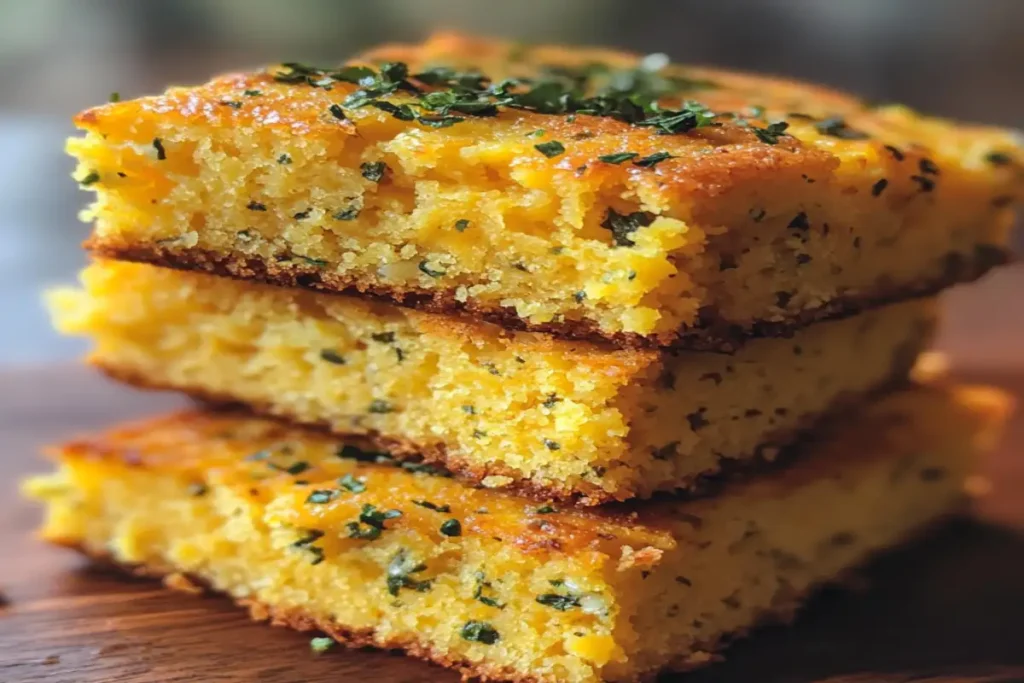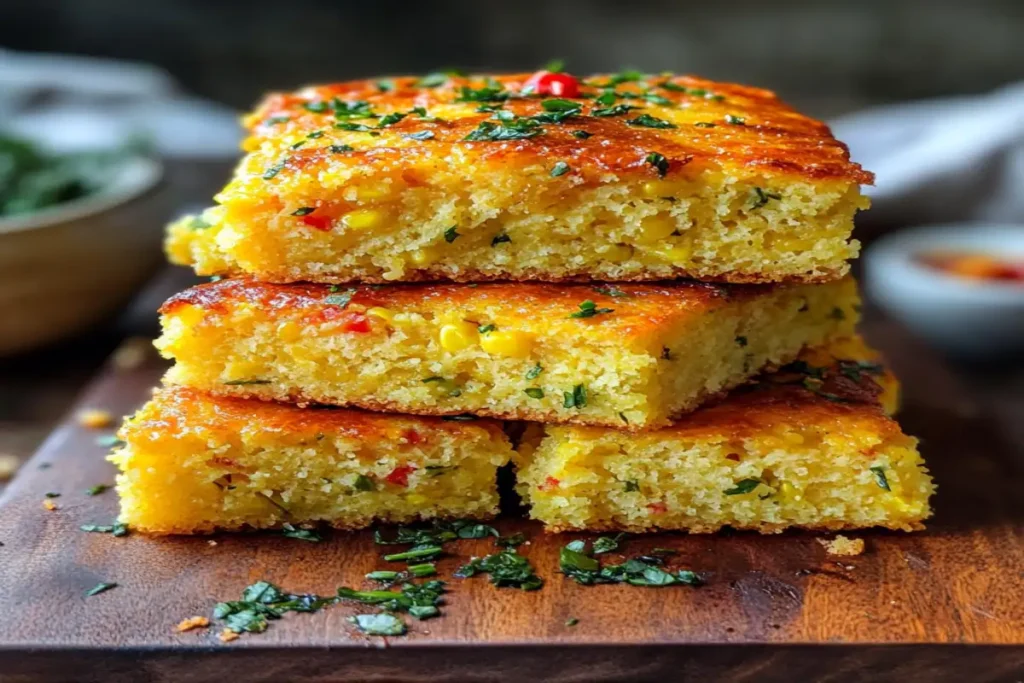Introduction to Southern Cornbread
A southern cornbread recipe is more than just a dish; it is a celebration of Southern culture and cuisine. Known for its rich flavor and rustic texture, Southern cornbread has a unique place in many kitchens. This recipe embodies comfort and simplicity, making it a staple for family dinners and gatherings. Whether served alongside hearty stews or as a standalone snack, this dish never fails to impress. As you embark on your culinary journey to create the perfect southern cornbread recipe, you’ll discover that it’s not just about following steps but also about honoring tradition.
This article will provide detailed insights into making authentic Southern cornbread, including tips on selecting ingredients, preparing your skillet, and enhancing its taste. From the history to the technique, you’ll gain all the knowledge needed to master this beloved dish.
The History and Tradition of Southern Cornbread
The southern cornbread recipe dates back to the early settlers who adapted Native American cooking methods to create this now-classic dish. Originally made from ground cornmeal and water, it evolved as European settlers introduced ingredients like eggs and milk.
Cornbread became a cornerstone of Southern cuisine due to its affordability and versatility. Unlike sweetened Northern-style cornbread, the Southern version is savory, reflecting the practical cooking traditions of the region. Families passed down their unique recipes, adding personal touches that made every batch special.
This tradition of customization continues today, with modern recipes including everything from jalapeños to cheddar cheese. Despite these variations, the essence of southern cornbread recipe remains intact—simple, flavorful, and deeply rooted in history.
Essential Ingredients for a Classic Southern Cornbread Recipe
To create an authentic southern cornbread recipe, using high-quality ingredients is essential. Here’s what you’ll need:
- Cornmeal: The foundation of the recipe; choose stone-ground for a robust flavor.
- Flour: A small amount adds structure and balance.
- Baking Powder: Ensures a light, fluffy texture.
- Salt: Enhances the natural flavor of the cornmeal.
- Buttermilk: Provides tanginess and moisture.
- Eggs: Help bind the mixture together.
- Butter or Lard: Adds richness and creates a crisp crust.
Every ingredient in the southern cornbread recipe plays a role in achieving the perfect balance of flavor and texture. Ensure freshness to elevate the dish’s authenticity and taste.

Choosing the Right Cornmeal for Authentic Flavor
The star of any southern cornbread recipe is the cornmeal. Selecting the right type is crucial for achieving authentic flavor and texture.
- Stone-Ground Cornmeal: Offers a coarse texture and rich, nutty flavor.
- Yellow Cornmeal: Traditional choice for its natural sweetness and vibrant color.
- White Cornmeal: A milder alternative often used in classic Southern recipes.
Avoid pre-mixed cornbread blends, as they may contain sweeteners or additives that can detract from the authenticity. Always read labels to ensure you’re using pure cornmeal, which allows the dish’s true essence to shine.
Step-by-Step Guide to Making Southern Cornbread
Creating a southern cornbread recipe from scratch is straightforward when you follow these steps:
- Preheat the Oven: Set your oven to 425°F and place your cast-iron skillet inside.
- Mix the Dry Ingredients: Combine cornmeal, flour, baking powder, and salt in a bowl.
- Prepare the Wet Ingredients: Whisk together buttermilk and eggs in a separate bowl.
- Combine Mixtures: Gradually fold the wet ingredients into the dry mixture.
- Add Melted Butter: Stir in melted butter to enhance flavor and ensure moisture.
- Pour Batter: Carefully pour the batter into the preheated skillet.
- Bake: Cook for 20–25 minutes until golden brown.
Following this process ensures that your southern cornbread recipe turns out perfectly every time.
Preparing Your Cast-Iron Skillet for Perfect Cornbread
A well-prepared skillet is essential for a flawless southern cornbread recipe. Cast iron is favored for its ability to retain heat and create a crisp, golden crust.
- Season the Skillet: Coat it with a thin layer of oil and heat to prevent sticking.
- Preheat the Skillet: Place it in the oven as it preheats to ensure even cooking.
- Handle with Care: Use oven mitts to handle the hot skillet and pour the batter quickly to retain heat.
Taking these steps guarantees that your southern cornbread recipe achieves its signature texture and flavor.
Tips for Achieving the Perfect Golden Crust
The crust is a defining feature of any southern cornbread recipe. To get it just right:
- Preheat your skillet until it’s smoking hot.
- Use butter or bacon grease to coat the skillet for extra flavor.
- Avoid over-mixing the batter to prevent a dense texture.
These techniques ensure your cornbread has a delightful contrast between its crispy exterior and soft interior.
Variations and Add-Ins: Taking Your Cornbread to the Next Level
While the classic southern cornbread recipe is delicious on its own, adding creative touches can make it even more exciting. Consider these variations:
- Savory Add-Ins: Jalapeños, cheddar cheese, or crumbled bacon.
- Herbs: Fresh rosemary, thyme, or chives.
- Sweet Notes: A touch of honey or a handful of corn kernels.
These additions allow you to tailor the southern cornbread recipe to suit your taste while preserving its traditional roots.

How to Serve Southern Cornbread: Pairing Suggestions
A southern cornbread recipe is incredibly versatile, making it a delightful addition to a variety of meals. Its savory flavor and crumbly texture complement numerous dishes, making it a go-to side for both casual and formal occasions.
- Classic Pairings: Serve with hearty dishes like chili, beef stew, or collard greens to balance the robust flavors.
- Breakfast Option: Pair cornbread with scrambled eggs, bacon, or honey for a comforting morning meal.
- Snack or Appetizer: Serve with a side of whipped butter or pimento cheese for a quick and flavorful snack.
Whether as an accompaniment to rich main courses or as a standalone treat, your southern cornbread recipe can adapt to any culinary setting.
Decorating and Presenting Your Cornbread for Special Occasions
While a southern cornbread recipe is known for its rustic charm, thoughtful presentation can elevate it for special gatherings. Simple touches can make your dish visually appealing while retaining its traditional appeal.
- Herb Garnishes: Sprinkle freshly chopped parsley, chives, or rosemary on top for a touch of elegance.
- Creative Shapes: Use cast-iron molds to create festive or themed cornbread designs.
- Plating Techniques: Arrange cornbread slices neatly in a basket lined with a cloth napkin for a homely yet stylish look.
By incorporating these presentation ideas, your southern cornbread recipe will become a feast for both the eyes and the palate.
Common Mistakes to Avoid When Making Southern Cornbread
Even a well-practiced cook can stumble when attempting a southern cornbread recipe. Avoid these common pitfalls to ensure success:
- Overmixing the Batter: This can lead to dense and tough cornbread. Mix just until combined.
- Skipping Skillet Preheating: A cold skillet results in a lackluster crust. Always preheat your skillet.
- Using Sweetened Cornmeal: This alters the savory flavor of traditional Southern cornbread. Opt for pure cornmeal.
- Neglecting Freshness: Expired baking powder or old cornmeal can ruin the texture and taste.
By sidestepping these mistakes, your southern cornbread recipe will shine every time.
Healthier Alternatives for Southern Cornbread Recipes
For those seeking a lighter twist on the classic southern cornbread recipe, a few modifications can make it more nutritious without compromising flavor.
- Whole-Grain Cornmeal: Swap regular cornmeal for whole-grain varieties to increase fiber content.
- Greek Yogurt: Use Greek yogurt instead of buttermilk for a protein boost.
- Olive Oil: Replace butter with heart-healthy olive oil to reduce saturated fat.
- Low-Sodium Options: Opt for unsalted butter and reduce added salt for a lower-sodium version.
These changes allow you to enjoy the timeless appeal of a southern cornbread recipe while aligning with your health goals.
Storing and Reheating Southern Cornbread Without Losing Its Flavor
Proper storage and reheating methods ensure that your southern cornbread recipe remains fresh and flavorful for days.
- Storage Tips:
- Wrap cornbread tightly in aluminum foil or plastic wrap.
- Store at room temperature for up to two days or refrigerate for longer freshness.
- Reheating Techniques:
- Use an oven set to 350°F to warm cornbread without drying it out.
- Wrap slices in foil to maintain moisture during reheating.
By following these guidelines, you can enjoy your southern cornbread recipe at its best, even as leftovers.
FAQs About Southern Cornbread Recipes
What is the difference between cornbread and southern cornbread?
The primary difference lies in flavor and texture. While cornbread, in general, may include sugar and have a slightly sweeter taste, southern cornbread is traditionally savory and focuses on the natural flavor of cornmeal. Additionally, Southern cornbread is often denser, with a crumbly texture, whereas other styles may incorporate more flour to create a lighter consistency. This distinction reflects regional preferences and culinary traditions, making southern cornbread recipes unique.
Why do Southerners not put sugar in cornbread?
Southerners typically omit sugar because they prioritize the cornmeal’s natural flavor. Historically, sugar was a luxury ingredient, and traditional recipes relied on simple, available ingredients. Furthermore, adding sugar shifts the dish’s profile, making it closer to a cake than a savory bread. As a result, Southern cooks maintain this practice to honor the authenticity of southern cornbread recipes.
Is it better to use milk or buttermilk in cornbread?
Using buttermilk is usually better because it enhances the tangy flavor and improves the bread’s texture. The acidity in buttermilk reacts with leavening agents like baking powder, creating a lighter, fluffier result. While regular milk can work in a pinch, opting for buttermilk ensures your southern cornbread recipe achieves its signature moistness and depth of flavor.
What milk is best for cornbread?
The best milk for southern cornbread recipes depends on the flavor and texture you want. Buttermilk is the traditional choice because of its tangy taste and ability to create a tender crumb. If buttermilk isn’t available, whole milk is the next best option, as it provides richness without diluting the flavor. Alternatives like almond milk or oat milk can work for those avoiding dairy, but they may alter the taste slightly.
Should you let cornbread batter rest before baking?
Yes, letting the batter rest briefly can improve the final texture. As the batter sits, the cornmeal absorbs the liquid, softening and enhancing the bread’s crumb. A 10-minute rest before pouring the batter into the skillet can also allow air bubbles to stabilize, resulting in an evenly baked southern cornbread recipe. Skipping this step won’t ruin the dish, but it can make a noticeable difference.
Conclusion: Bringing Comfort and Tradition to Your Table
A southern cornbread recipe is more than just a dish; it’s a piece of culinary heritage that connects generations. With its savory richness and adaptability, this classic recipe embodies the heart of Southern cooking.
By understanding its history, perfecting its preparation, and adding your unique touch, you can create a cornbread that resonates with warmth and tradition. Whether enjoyed fresh out of the oven or as a cherished leftover, Southern cornbread always delivers comfort to your table.

